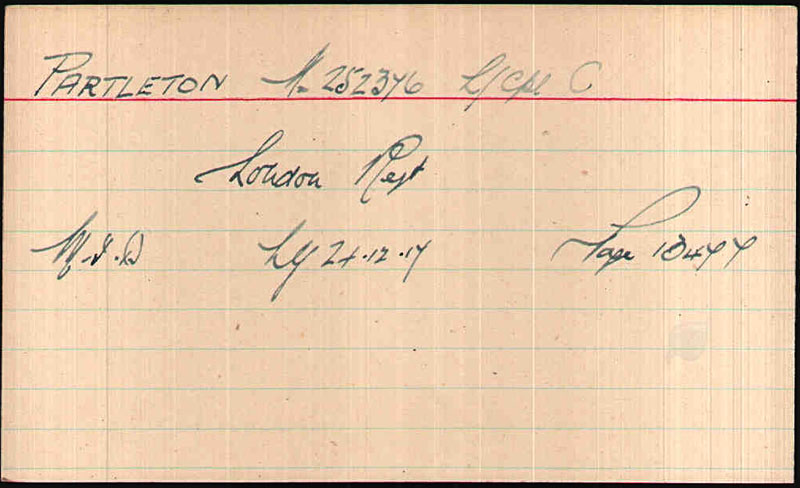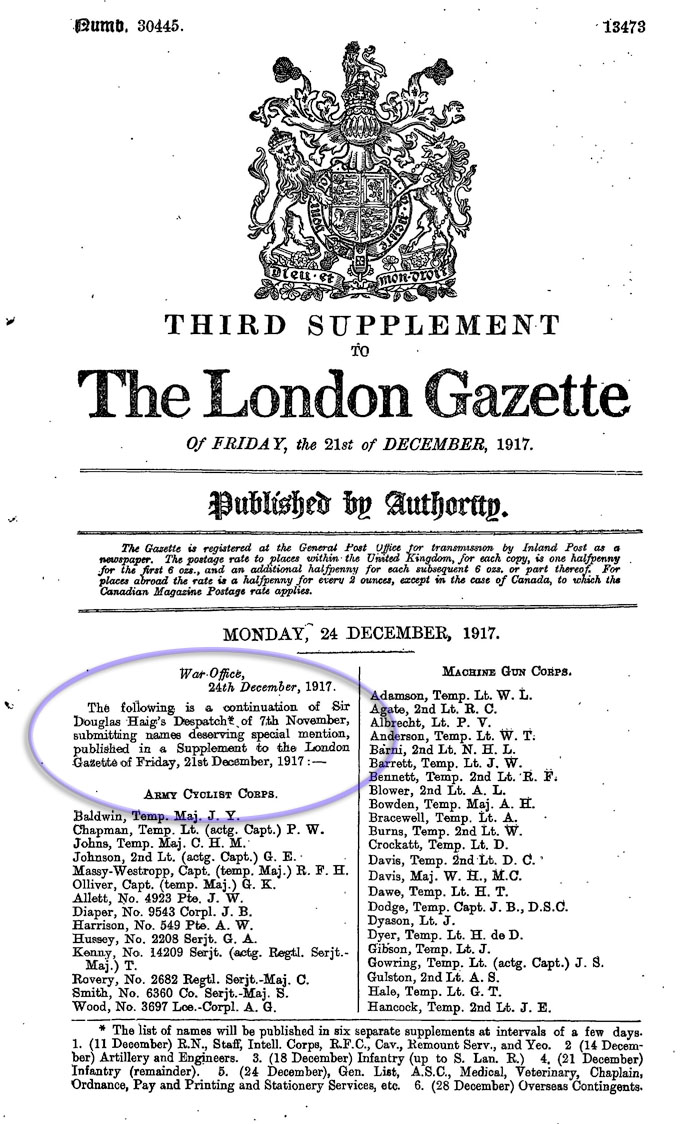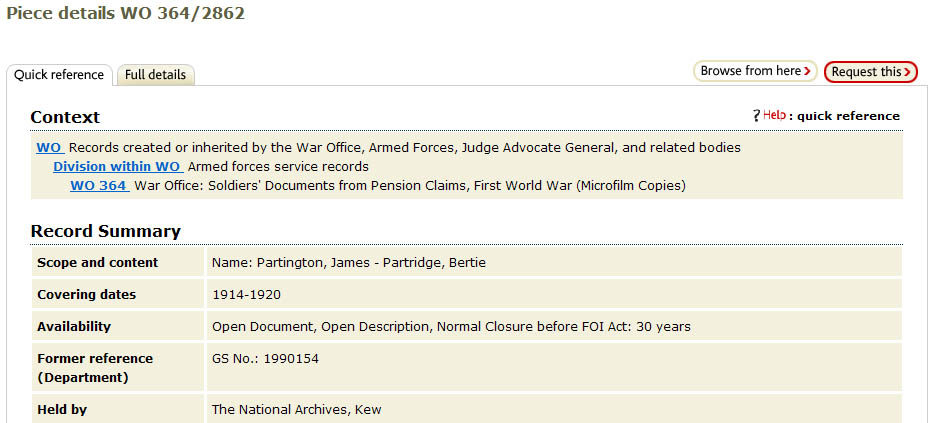


Charles 'Wag' Partleton (1868 - bef.1921)
Addendum
This page is an addendum to the story of Charles 'Wag' Partleton. Click here to return to Part 1.
The purpose of this page is to gather together the clues to find Waggy. How did it come about that he went missing at the end of his life?
The first things we have are WW1 Medal Cards. The Medal Card we see below was created in 1920 for Lance-Corporal Charles Partleton 252376 of the 3rd London Regiment. This is probably Wag, but somehow we have to prove it:

The more I look at this, the more I convince myself that this person must be Wag, though, frustratingly, there's insufficient information on the card. No age, no address, no next of kin. However - there are only two Charles Partletons whom it could possibly be - Waggy or his very distant cousin Charles Benjamin Partleton (1894 -1987) who had been born in the East End of London. But there's no middle name on the card (and Waggy didn't have one)... and wouldn't the Army generally insist on the soldier's full name or at least full initials if it were Charles Benjamin Partleton?
The 3rd London Regiment was part of the Territorial Army - the British Army's reservist force. We know that Wag had been a reservist, as it was mentioned at his trial in 1903.
The codes on the card refer to medal entitlements and a Roll Number - TP3/101 B2, on page 203. That'll be a long list of soldiers entitled to medals. If we could find this, there might be a clue.
For those of us who aren't soldiers, here's my analysis of a bit of British Army structure:
A Regiment is a military unit, commanded by a Colonel. It comprises of 3 to 7 standard Battalions - roughly up to 5,000 soldiers. [Waggy is in the 3rd London Regiment, a Territorial Army force].
A Battalion is a military unit of around 500-1500 men usually consisting of between two and seven Companies and typically commanded by a Lieutenant Colonel. Several battalions are grouped to form a regiment . We don't know what Battalion Waggy was in.
A Company is a military unit, typically consisting of 75-200 soldiers. Most companies are formed of three to five platoons although this may vary. Several companies are grouped to form a battalion.
A soldier's Unit can mean any of the above.
Thus, knowing Wag's regiment narrows our list down to about 5000 men. The rank of Corporal would certainly make sense for Waggy - he had eight years experience in India and had also served in the Boer War.
Here's the reverse of the card:

The back of the card has been deciphered [by comparison with other cards]: it says "Officer in Charge of Records in London Suggests Nominal Roll of Individuals Entitles to Emblem. 18 March 1920". Charles gets an emblem because he was Mentioned in Despatches as we shall see in a moment. The emblem is probably an oak leaf.
Here's the only other army record we have for Lance-Corporal Charles Partleton 252376. Another medal card, this one created to record the fact that he was Mentioned in Despatches:

Thankfully, this was photographed alongside other similar cards which gave us some crucial clues as to what all this shorthand means. What looks like LY 24-12-17 is actually LG 24-12-17. This is a reference to The London Gazette of 24 December 1917. And what looks like Page 10477 is actually 13477... Handwriting, eh!
Thus we are able to locate a scan of page 13477 from The London Gazette online archive:

It's a list of names. What's the significance of this list?
For that we need to see the front sheet - page 13473:

So, Lance-Corporal Charles Partleton 252376 of the 3rd London Regiment is a name "deserving special mention". The usual phrase for this is "Mentioned in Despatches", and it's why Corporal Partleton got his Oakleaf emblem. But there's no clue as to why Charles Partleton was commended, ie the Citation.
So, what was his courageous act? Let's consult the help-page of the National Archives on the subject of Medal Cards, with reference to Citations:

Unfortunately, though there was a full description on a Citation, the original document would have been given to Charles at the end of the war, and it probably doesn't survive. No copies were kept. We won't find it in the archive. It's lost.
So, the crucial question is this: Are Lance-Corporal Charles Partleton 252376 of the 3rd London Regiment, and Charles 'Wag' Partleton, the same person? The Medal Cards don't prove this one way or the other, but surely the Army holds more records than just Medal Cards?
The answer is yes, the Army kept tons of stuff - signing-on papers, attestations, medical reports, service records, punishment records, discharge records, wills; and all these were carefully held at a special records storage facility in Arnside Street, Walworth, London. By sheer coincidence this facility - which was for the whole country - just happened to be near to Lambeth, on Camberwell Road near to the church where Wag had been married in 1896:

On 07 September 1940, 22 years after the end of WW1 - during WW2 - Arnside Street was hit by incendiary bombs. Two thirds of all those WW1 records were destroyed. The records which survived - about 2 million of the original 6 million - were in many cases charred or water-damaged.
Ok, it was one of Hitler's least significant offences, but the consequence is that - aside from the medal cards - all the other army records of Charles Partleton 252376 were destroyed in 1940.
But all is not lost. We know from family oral history that Waggy was a Chelsea Pensioner, and there's every chance that these records survive. Chelsea Pensioners are a British institution representing the retirement of war veterans. Most people know them from images of old men in red coats like the one below: these former soldiers are in-pensioners who inhabit the Royal Chelsea Hospital - effectively an old-folks home for service personnel:

But Waggy certainly wasn't one of these old boys. He was only 50 at the end of WW1, and may have died before he was 53!!! The vast majority of Chelsea Pensioners are out-pensioners who are paid a pension but don't live at the Chelsea Hospital (which in any case can only accommodate a tiny number of people), and our Wag will have been one of these.
So, we need to find Waggy's Chelsea Pension records. These could unlock the mystery completely; they'd have his addresses and the date of the his death, at which the pension would cease to be paid.
One problem is that we don't know when his entitlement started. After the Boer War? After WW1? Here's the National Archives help-notes on the subject:

As we can see above, if Waggy's entitlement started before 1913, we might find him under WO117 - providing we are prepared to be very patient, searching year by year.
If it was after 1913, the guidance is not clear, but the best I can find is WO 364, Soldier's Documents from Pension Claims 1914-1920.
Here's the National Archives page on this subject: the names are listed in alphabetical order, so they should be very easy to look up, in this volume - Partington to Partridge:

The National Archive also hold other army records, for example Muster Rolls and Pay Lists which would apply to Waggy's early military service in India, archived under WO 16, but these won't help us find Wag at the end of his life.
Finally, there exist Absent Voters Lists for 1918 and 1919 for soldiers who aren't home to vote - many soldiers weren't demobbed until 1919. We need to locate the lists for Lambeth, or more likely Wandsworth, and we may find Waggy on these. I have read on the internet that the Wandsworth list exists, but at first glance I can't find it.
Conclusion:
If Waggy did sign-up for WW1 at the age of 44, as an experienced former soldier, and became Lance-Corporal Charles Partleton 252376 of the 3rd London Regiment, what became of this person?
Well, he is not listed in the rolls of the war dead of WW1, so we should be fairly sure he survived. But the Electoral Rolls from 1918 onwards show his wife Susan living at 27 Burtop Road, Earlsfield, with her family, but never Wag. Where is he?
Perhaps he'll reappear somewhere in the 1921 Census which was held on 19 June 1921 - we'll all have to wait a decade to see that. But don't hold your breath, because his daughter Olive declared him to be deceased on her marriage certificate of 22 May 1921. Why would she do that if he wasn't dead?
In March 1920 he had been awarded his Oak Leaf Emblem, but of course this could be posthumous. The Oak Leaf, which we see below, would be pinned to the ribbon of one his WW1 service medals:

One other observation I have is the fact that, though we have some scraps of oral history about Waggy's life, the verbal record of what happened to Wag in the end is silent. This may not be significant, but it also suggests the possibility that this information might have been hushed-up in the family. Just conjecture, I know.
Waggy has no Death Certificate at any date. There are a few possible causes for this:
1. He died outside of the United Kingdom
2. His name was mis-spelled on the UK Index of Deaths [An example is my own surname which is mis-spelled and is difficult to find on the UK Index of Births!]
3. He was using an assumed name
4. His identity was not identifiable upon death, such as might happen to a homeless person
Are we ever going to find Waggy? Did he stay on in France after WW1? Did he come home to Britain "unsettled" again and live under an assumed name or fall in into homelessness and alcoholism?
Only time will tell. We're working on it!
------ooooo0000ooooo------- Postscript ------ooooo0000ooooo-------
In February 2010, The Partleton Tree was contacted by Martin Harris who provided us with some excellent clues and pointers...

The search for Wag goes on...
If you enjoyed reading this page, you are invited to 'Like' us on Facebook. Or click on the Twitter button and follow us, and we'll let you know whenever a new page is added to the Partleton Tree:
Do YOU know any more to add to this web page?... or would you like to discuss any of the history... or if you have any observations or comments... all information is always welcome so why not send us an email to partleton@yahoo.co.uk
Click here to return to the Partleton Tree 'In Their Shoes' Page.
